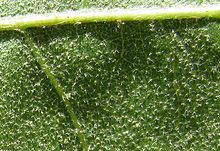- Quercus pagoda
-
Quercus pagoda
Cherrybark oakConservation status Scientific classification Kingdom: Plantae (unranked): Angiosperms (unranked): Eudicots (unranked): Rosids Order: Fagales Family: Fagaceae Genus: Quercus Section: Lobatae Species: Q. pagoda Binomial name Quercus pagoda
RafinesqueQuercus pagoda, the Cherrybark oak, is one of the most highly valued red oaks in the southern United States. It is larger and better formed than southern red oak and commonly grows on more moist sites. Its strong wood and straight form make it an excellent timber tree. Many wildlife species use its acorns as food, and cherrybark oak makes a fine shade tree.
Contents
Native range
Cherrybark oak is found in the Atlantic and Gulf Coastal Plain, from southeastern Virginia to northwestern Florida; west to eastern Texas; and north in the Mississippi Valley to extreme southeastern Oklahoma, southeastern Missouri, southern Illinois and southwestern Indiana.
Cherrybark oak is widely distributed on the best loamy sites on first bottom ridges, well-drained terraces, and colluvial sites. These sites occur along both large and small streams of the southeastern Coastal Plain and the Mississippi Valley north into Missouri and Illinois. The species is rare in the lower Mississippi Delta.
Description
Flowers: Cherrybark oak is monoecious; staminate and pistillate catkins are borne separately on the same tree. Catkins are borne on stalks from leaf axils of the current growth. Flowers appear from February to May, depending on latitude.
Acorns: The acorn is about 0.5 inches long, globular or hemispheric, with up to one-third of its length enclosed in a shallow thin cap. Acorns per pound range from 200 to 750. Acorns mature from August to November of the second year. Trees begin bearing acorns when they are about 25 years old, and optimum production is reached when they are between 50 and 75 years of age. Good acorn crops are frequent, occurring at 1- or 2-year intervals, with light crops in intervening years. Acorns are dormant and do not germinate until the following spring. Germination is hypogeal.
Size: Cherrybark oaks often attain heights of 100 to 130 feet and diameters of 36 to 60 inches, making it among the largest of the red oaks in the South. It is one of the hardiest and fastest growing oaks. It grows well on more sites than any other bottomland oaks except perhaps willow and water oaks. Diameter growth typically ranges from 3 to 6 inches per decade.
 Close-up view of stellate hairs on leaf underside.
Close-up view of stellate hairs on leaf underside.
Foliage: The name pagoda refers to the regularly tiered shape of cherrybark's leaves, which are reminiscent of the shape of a pagoda. Its simple, alternate leaves generally have V-shaped bases, uniformly shaped and deeply incised lobes (5 to 11), and short, broad, uncurved tips. Leaves are 7 to 10 inches long and up to 7 inches wide. Leaves are dark green, smooth, and shiny on the surface; undersides are paler and pubescent.
Twigs: Twigs are thick and brown or gray, hairy when young. The buds are egg-shaped with a pointed tip, angular, and hairy. In some regions, the twigs commonly bear galls.
Bark: The name 'cherrybark' comes from its similarity to the bark of black cherry. The bark is gray and has scaly, narrow ridges.
Similar species
In the past, cherrybark oak was classified as a variety (Q. falcata var. pagodafolia) of southern red oak (Quercus falcata). However, the two species are now recognized to significantly differ in several key morphological and ecological features. Cherrybark oak occurs on moist, bottomland sites, while southern red oak typically occurs in drier uplands sites with poor soil. Leaves of southern red oak generally have rounded (U-shaped) bases and fewer, more irregularly shaped lobes than cherrybark. The bark is distinctly different in cherrybark oak and southern red oak.
Cultivation
Natural reproduction occurs on areas protected from fire and grazing. Being intolerant of shade, cherrybark oak requires full light for development, which in turn promotes heavy competition from herbs, vines, and brush. Seedling development is typically good in old fields with well-drained loamy soils.
Acorn supply is one of the principal determinants of the amount of natural cherrybark oak reproduction. Other factors include microclimate, soil properties, and stand variables. Seedling development is related to overhead release, with large openings needed.
Cherrybark oak is often found as individual trees in mixed stands, where it usually occurs in a dominant or codominant position. Sometimes it is found in groups where it dominates a stand. Cherrybark cannot tolerate suppression for very long. It is classed as intolerant of shade and probably becomes established only in openings.
Uses
Cherrybark oak usually has a relatively branch-free merchantable bole in contrast with other bottomland red oaks such as water and willow oak. Because of its good form and quality, cherrybark is regarded as one of the best red oaks. The wood is heavy, hard, and coarse grained. It is used for interior finishing, veneer, general construction, furniture, and cabinets. Wood is light reddish brown.
Many wildlife species use cherrybark acorns as a substantial part of their diets. Common species are the gray and fox squirrel, white-tailed deer, raccoon, and many birds (such as wild turkey, blue jay, wood duck, and common grackle).
References
Categories:- NatureServe Secure species
- Quercus
- Trees of the Southeastern United States
- Trees of the Plains-Midwest (United States)
- Trees of Eastern Texas
- Trees of North Carolina
- Trees of Arkansas
- Trees of Mississippi
- Trees of Tennessee
- Trees of Louisiana
- Trees of Virginia
- Flora of the Southeastern United States
Wikimedia Foundation. 2010.

